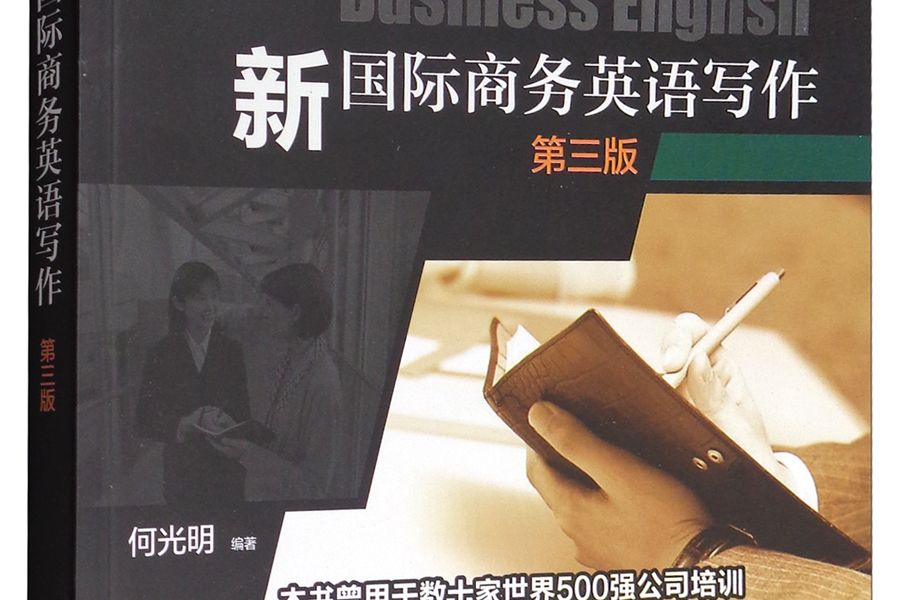內容簡介
本書作者結合多年商務英語寫作教學以及外企商務英語培訓經驗,並吸收諸多新的網路商務信息,打造了這本在內容選材新穎、設計編排具可操作性的商務英語寫作書。
內容方面,本書涵蓋了商務活動中常見的寫作話題,提供了詳細的寫作技巧講解,精選了大量的新商務寫作範例,並新增了“商務郵件寫作必背300句”。
圖書目錄
Section 1:General Tips for Modern Business Writing(現代商務寫作技巧概述)
1.1 Avoidingwordy and redundantphrases(避免措辭拖沓冗長、累贅重複)
1.2 Using small words(使用簡單辭彙)
1.3 Avoiding sexist language(避免使用有性別歧視意味的辭彙)
1.4 Using modern business language(使用現代商務用語)
1.5 Using less cliches and jargon(少用陳詞濫調及商業行話)
1.6 Avoiding vague expressions(避免使用意思模糊的表達)
1.7 Avoiding negative wording(避免使用否定的措辭)
1.8 Knowing the proper use of the commonly misused words and phrases(正確使用易混淆、誤用的辭彙)
1.9 Using active voice more(使用主動語態)
1.10 Using more short sentences(多使用短句)
1.11 Using anatural,conversational style(風格自然、口語化)
1.12 Using courteous expressions(措辭禮貌得體)
1.13 Using YOUR attitude(為對方著想)
1.14 Using more paragraphs(使用小段落)
1.15 Shortening or deleting warming.up paragraphs(縮短或刪除寒暄及不切題的段落)
1.16 Identifying the purpose ofthe writing in the beginning(開頭點明寫作目的)
1.17 Basing your opinion on facts(觀點基於事實)
1.18 Crossing outunnecessary closings(結尾避免畫蛇添足)
Section 2:Grammar Focus(聚焦語法)
2.1 Sentence construction(1)(句子結構Ⅰ)
2.2 Sentence construction(2)(句子結構Ⅱ)
2.3 Avoiding awkward constructions(1)(避免錯誤句子結構Ⅰ)
2.4 Avoiding awkward constructions(2)(避免錯誤句子結構Ⅱ)
2.5 The use ofpunctuation(標點符號的使用)
2.6 Rules ofcapitalization(字母大寫規則)
2.7 The usage ofprepositions(介詞的用法)
2.8 The paragraph(段落)
Section 3:Memorandums(Interoffice Memos)(辦公室便函)
3.1 What is a memo?(什麼是辦公室便函?)
3.2 The purpose ofa memo(辦公室便函的目的)
3.3 The layout ofa memo(辦公室便函的格式)
3.4 Memos and emails(辦公室便函與電子郵件)
3.5 Tips for writing a memo(辦公室便函寫作技巧)
3.6 Samples(範例)
Section 4:Emails(電子郵件)
4.1 What is an email?(什麼是電子郵件?)
4.2 The layout ofa letter(信件的格式)
4.3 The layout ofan email(電子郵件的格式)
4.4 Beginnings and endings of an email(電子郵件的開頭句與結尾句)
4.5 Emails and letters(電子郵件與信件)
4.6 Five golden rules for writing emails(5C's)(電子郵件寫作的五大黃金規則)
4.7 Tips for writing emails(電子郵件的寫作技巧)
4.8 Business email netiquette(商務電子郵件相關禮儀)
4.9 Samples(範例)
Section 5:Faxes(傳真)
5.1 What is a fax?(什麼是傳真?)
5.2 Components ofa fax(傳真的構成部分)
5.3 The format ofa fax(傳真的格式)
5.4 The pages ofa fax(傳真的頁數)
5.5 Samples(範例)
Section 6:Notices and Instructions(通知)
6.1 What is a notice or an instruction?(什麼是通知?)
6.2 Principles for writing a notice or an instruction(通知的寫作原則)
6.3 Guidelines to remember(通知的寫作要領)
6.4 Components ofa notice or an instruction(通知的構成部分)
6.5 Samples(範例)
Section 7:Agendas and Minutes(會議議程、會議記錄)
7.1 Agendas(會議議程)
7.2 Tips for creating effective agendas(會議議程寫作技巧)
7.3 Agenda samples(會議議程範例)
7.4 Minutes(會議記錄)
7.5 Steps for minutes taking and writing(會議記錄的步驟)
7.6 Components ofminutes(會議記錄的構成部分)
7.7 Tips for the minutes taker(會議記錄技巧)
7.8 Common symbols for minutes taking(常用會議記錄縮寫符號)
7.9 Minutes samples(會議記錄範例)
Section 8:Business Reports(商務報告)
8.1 What is a business report?(什麼是商務報告?)
8.2 A general structure for formal business reports(正式商務報告的常見結構)
8.3 Suggested structures for other kinds of reports(其他商務報告的一般結構)
8.4 Tips for improving report readability(如何提高報告的可讀性)
8.5 Formal business report writing process(正式商務報告的寫作過程)
8.6 Common expressions for business reports(商務報告的常用語)
8.7 Report samples in the appendix(報告範例參見附錄)
Section 9:Proposals(建議書)
9.1 What is a proposal?(什麼是建議書?)
9.2 Goldenrules forwriting aproposal(建議書的寫作原則)
9.3 Tips for writing business proposals(建議書的寫作技巧)
9.4 Components ofan informal proposal(非正式建議書的構成部分)
9.5 Components ofa formal proposal(正式建議書的構成部分)
9.6 Samples(範例)
Section 10:Contracts and Agreements(契約與協定)
10.1 What are an agreement and a contract?(什麼是協定與契約?)
10.2 Components ofcontracts and agreements(契約與協定的構成部分)
10.3 Main types of contracts and agreements(契約與協定的主要類型)
10.4 Components ofa commercial contract(商業契約的基本內容)
10.5 Samples(範例)
Section 11:Resume(CV),Application Letters,and Follow-up Thank-You Letters(簡歷、求職信、面試後感謝信)
11.1 What is a resume(curriculum vitae)?(什麼是簡歷?)
11.2 Tips for writing winning resumes(成功簡歷的寫作技巧)
11.3 Resume samples(簡歷範例)
11.4 Common expressions for resumes(簡歷的常用語)
11.5 What is an application letter?(什麼是求職信?)
11.6 Tips for writing winning application letters(成功求職信的寫作技巧)
11.7 Application letter samples(求職信範例)
11.8 Common expressions for application letters(求職信的常用語)
11.9 What is a follow-up thank-you letter?(什麼是面試後感謝信?)
11.10 A Sample ofa follow-up thank-you letter(面試後感謝信範例)
Section 12:Letters for Social Purposes(社交信函)
12.1 Letters of introductions,recommendations and references(介紹、推薦及證明信)
12.2 Letters ofinvitations and their reply(邀請信及其回信)
12.3 Letters ofthanks(感謝信)
12.4 Letters of goodwill-congratulations,encouragement,condolence,commending,seasonalwishes(友好祝願信——祝賀、鼓勵、慰問、表揚、季節問候)
Section 13:Letters for Other Purposes(其他目的的信函)
13.1 Letters ofapologies(致歉信)
13.2 Letters for requesting favors(求助信)
13.3 Letters forbooking(預訂信)
13.4 Letters for making an appointment(預約信)
13.5 Letters ofconfirmation(確認信)
13.6 Letters for calling for an interview(通知面試信)
13.7 Letters ofresignation(辭職信)
Section 14:Letters and Vocabulary for Import and Export Business(進出口業務信函及辭彙)
14.1 Establishing business relations(建立業務聯繫——流程1)
14.2 Inquiries(詢問/詢價——流程2)
14.3 Replies and offers(回函與報盤——流程3)
14.4 Acceptance and orders(接受與訂購——流程4)
14.5 Standing enquiries(資信調查——流程5)
14.6 Packing(包裝——流程6)
14.7 Insurance(保險——流程7)
14.8 Shipment(裝運——流程8)
14.9 Payment by L/C(信用證支付——流程9)
14.10 Other modes ofpayment(其他支付方式——流程10)
14.11 Collection(催款——流程11)
14.12 Complaints and claims(抱怨與索賠——流程12)
14.13 Claim settlement(理賠——流程13)
14.14 Agency(代理——流程14)
14.15 Compensation trade and processing with supplied materials(補償貿易與來料加工——流程15)
Appendix(附求)
Answer Key(參考答案)
商務郵件寫作必背300句

